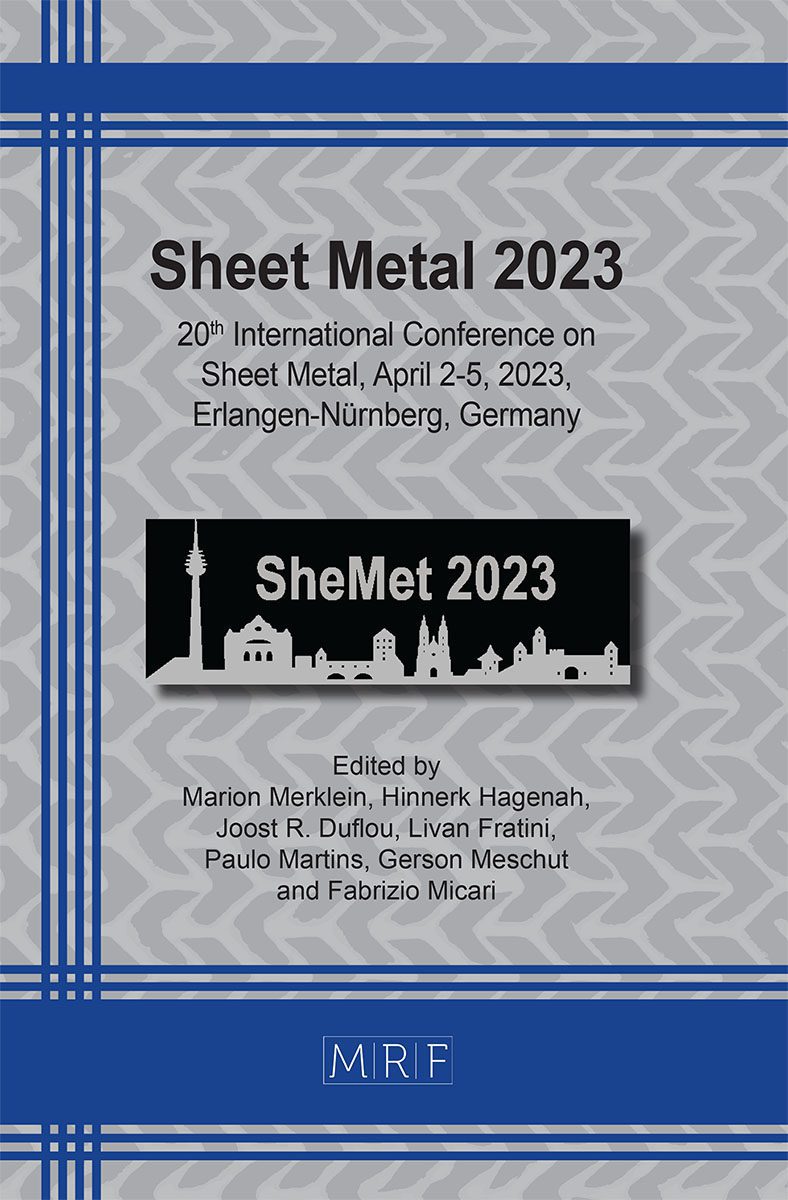On the utilization of radial extrusion to characterize fracture forming limits. Part I – methodology and tooling
Rui F.V. Sampaio, João P.M. Pragana, Ivo M.F. Bragança, Carlos M.A. Silva, Chris V. Nielsen, Paulo A.F. Martins
download PDFAbstract. This paper and its second part introduce a new formability test based on double-action radial extrusion to characterize material formability in the bulk-to-sheet material flow transitions that are commonly found in metal forming. This first part draws from the presentation of a multidirectional tool, which was designed to convert the vertical press stroke into horizontal movement of the extrusion punches towards each other, to aspects of experimental strain determination, fractography and finite element analysis. The methodology and tooling that are introduced here pave the way for subsequent testing and modelling of the different modes of fracture in three-dimensional to plane-stress evolutions, typical of bulk-to-sheet material flow transitions, by means of the new proposed test.
Keywords
Forming, Failure, Stress State Transitions
Published online 3/17/2023, 8 pages
Copyright © 2023 by the author(s)
Published under license by Materials Research Forum LLC., Millersville PA, USA
Citation: Rui F.V. Sampaio, João P.M. Pragana, Ivo M.F. Bragança, Carlos M.A. Silva, Chris V. Nielsen, Paulo A.F. Martins, On the utilization of radial extrusion to characterize fracture forming limits. Part I – methodology and tooling, Materials Research Proceedings, Vol. 25, pp 229-236, 2023
DOI: https://doi.org/10.21741/9781644902417-29
The article was published as article 29 of the book Sheet Metal 2023
![]() Content from this work may be used under the terms of the Creative Commons Attribution 3.0 licence. Any further distribution of this work must maintain attribution to the author(s) and the title of the work, journal citation and DOI.
Content from this work may be used under the terms of the Creative Commons Attribution 3.0 licence. Any further distribution of this work must maintain attribution to the author(s) and the title of the work, journal citation and DOI.
References
[1] H.A. Kuhn, P.W. Lee, T. Erturk, A Fracture criterion for cold forming, Journal of Engineering Materials and Technology 95 (1973) 213–218. https://doi.org/10.1115/1.3443155
[2] P.A.F. Martins, N. Bay, A.E. Tekkaya, A.G. Atkins, Characterization of fracture loci in metal forming, International Journal of Mechanical Sciences 83 (2014) 112–123. https://doi.org/10.1016/j.ijmecsci.2014.04.003
[3] S. Kobayashi, Deformation characteristics and ductile fracture of 1040 steel in simple upsetting of solid cylinders and rings, Journal of Engineering for Industry 92 (1970) 391–398. https://doi.org/10.1115/1.3427752
[4] E. Erman, H.A. Kuhn, G. Fitzsimons, Novel test specimens for workability testing, in: R. Chait, R. Papirno (Eds.), Compression Testing of Homogeneous Materials and Composites, ASTM International, West Conshohocken, USA, 1983, pp. 279–90. https://doi.org/10.1520/STP36209S
[5] A.G. Atkins, Fracture in forming, Journal of Materials Processing Technology 56 (1996) 609–618. https://doi.org/10.1016/0924-0136(95)01875-1
[6] J.P. Magrinho, M.B. Silva, L.M. Alves, A.G. Atkins, P.A.F. Martins, New methodology for the characterization of failure by fracture in bulk forming, The Journal of Strain Analysis for Engineering Design 53 (2018) 242–247. https://doi.org/10.1177/0309324718758842
[7] R.F.V. Sampaio, J.P.M. Pragana, I.M.F. Bragança, C.M.A. Silva, P.A.F. Martins, Revisiting the fracture forming limits of bulk forming under biaxial tension, International Journal of Damage Mechanics 31 (2022) 882-900. https://doi.org/10.1177/10567895211072580
[8] C.M.A. Silva, L.M. Alves, C.V. Nielsen, A.G. Atkins, P.A.F. Martins, Failure by fracture in bulk forming, Journal of Materials Processing Technology 215 (2015) 287-298. https://doi.org/10.1016/j.jmatprotec.2014.08.023
[9] M.G. Cockroft, D.J. Latham, Ductility and the workability of metals, Journal of the Institute of Metals 96 (1968) 33–9.
[10] F.A. McClintock, A Criterion for ductile fracture by the growth of holes, Journal of Applied Mechanics 35 (1968) 363–371. https://doi.org/10.1115/1.3601204
[11] L. Xue, T. Wierzbicki, Ductile fracture initiation and propagation modeling using damage plasticity theory, Engineering Fracture Mechanics 75 (2018) 3276–3293. https://doi.org/10.1016/j.engfracmech.2007.08.012
[12] R. Balendra, Process mechanics of injection upsetting, International Journal of Machine Tool Design and Research 25 (1985) 63-73. https://doi.org/10.1016/0020-7357(85)90058-7
[13] C.V. Nielsen, P.A.F. Martins Metal Forming: Formability, Simulation, and Tool Design, 1st ed, Academic Press New York, 2021. https://doi.org/10.1016/B978-0-323-85255-5.00006-6
[14] G. Martello, Discretization analysis in FEM models, in: V. Murgul (Ed.) International Scientific Conference Week of Science in SPbPU – Civil Engineering, Saint-Petersburg, Russia. MATEC Web of Conferences 53 (2016) 01063. https://doi.org/10.1051/matecconf/20165301063































